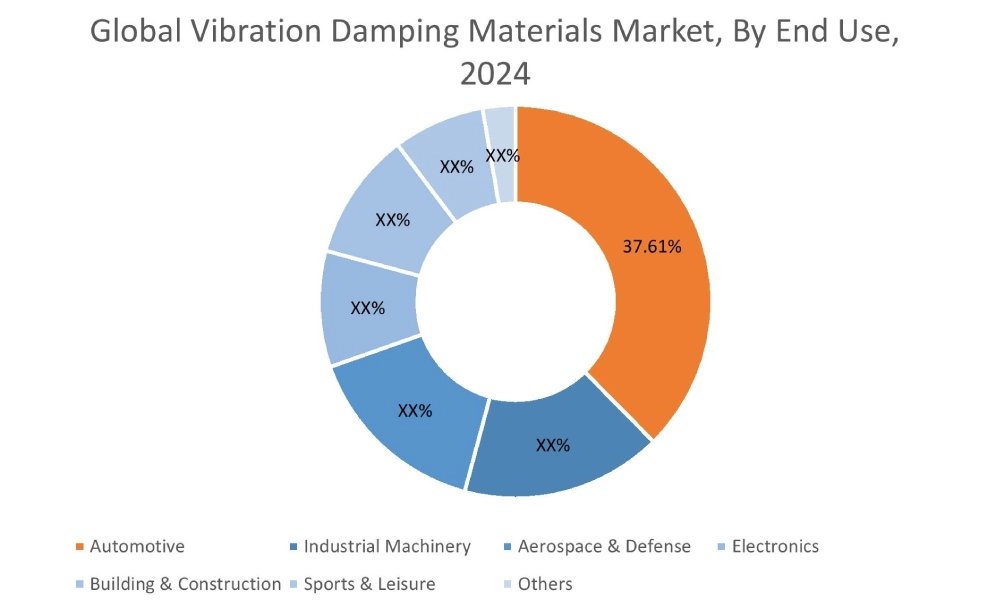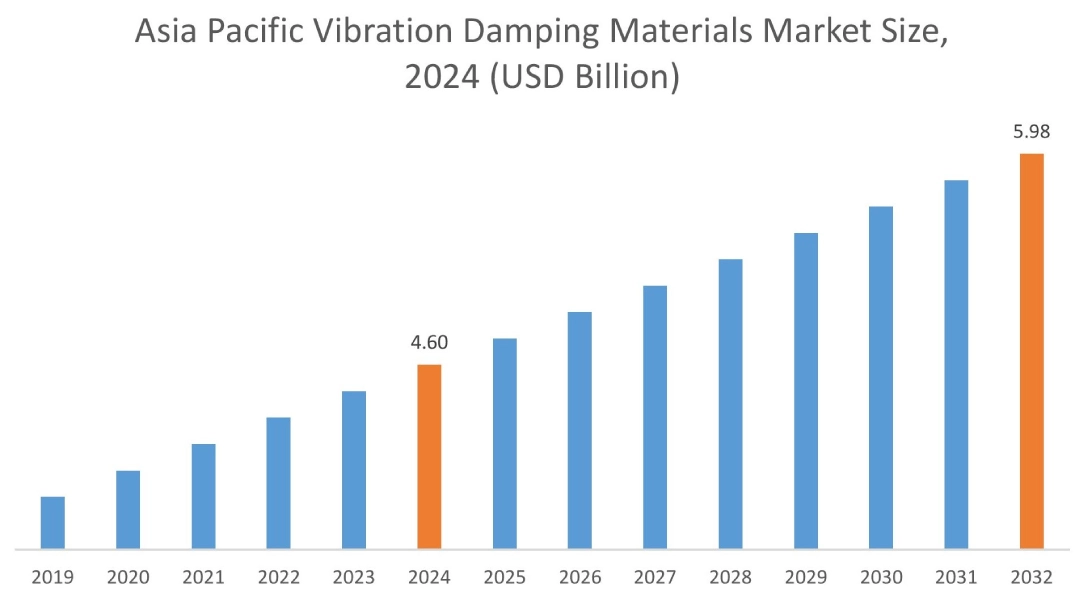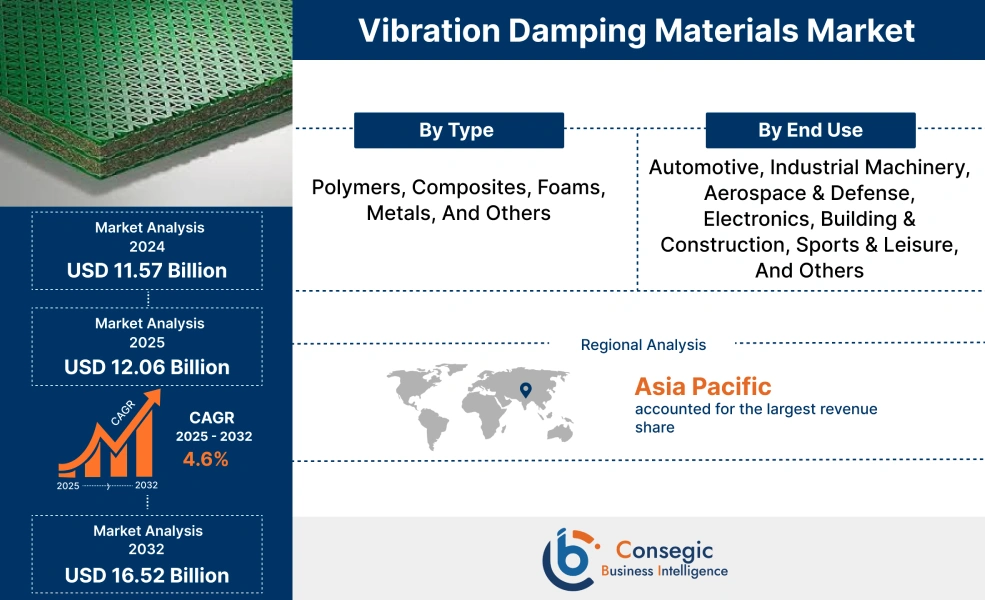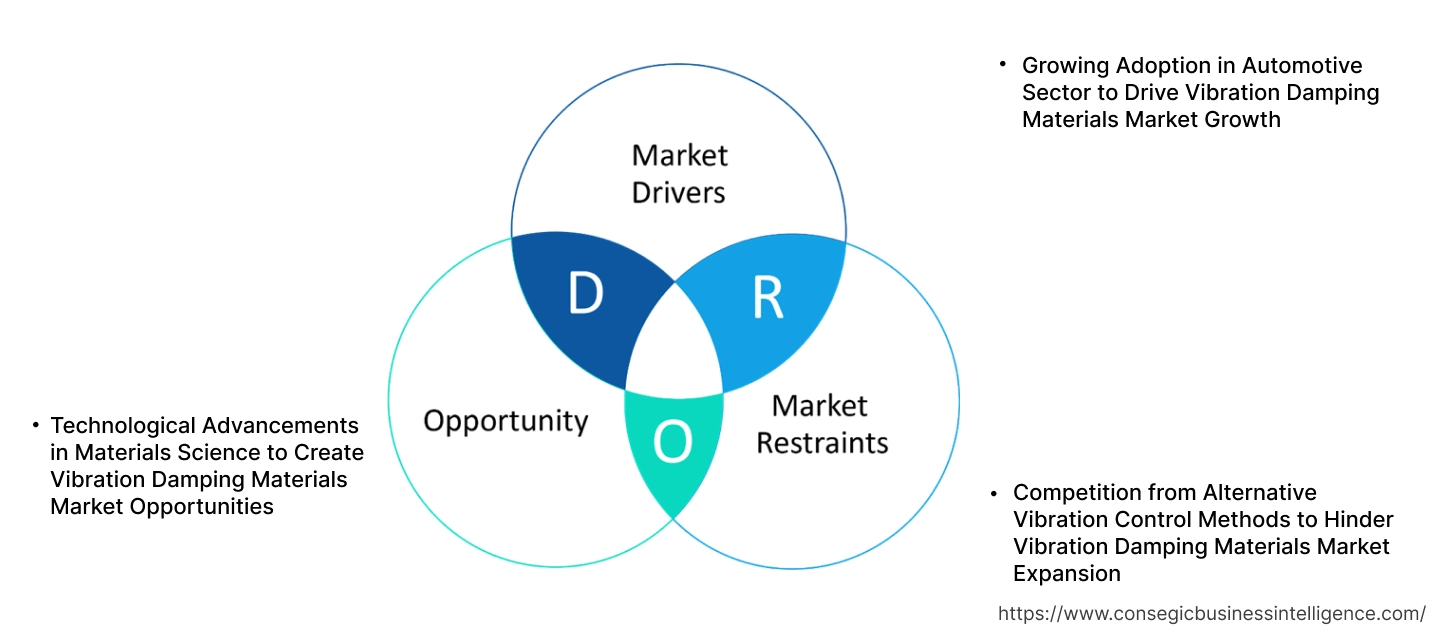Vibration Damping Materials Market Size:
The Vibration Damping Materials Market size is growing with a CAGR of 4.6% during the forecast period (2025-2032), and the market is projected to be valued at USD 16.52 Billion by 2032 from USD 11.57 Billion in 2024. Additionally, the market value for 2025 is attributed to USD 12.06 Billion.
Vibration Damping Materials Market Scope & Overview:
Vibration damping materials are specialized substances engineered to mitigate unwanted vibrations within a system by converting mechanical energy into other forms, primarily heat. This conversion process is achieved through the material's inherent viscoelastic properties, allowing it to deform under stress and then gradually return to its original shape, dissipating energy during this cycle. These materials are crucial in numerous applications for their ability to reduce noise, prevent structural fatigue, and enhance the overall performance and longevity of machinery and structures across diverse sectors such as automotive, aerospace, electronics, and construction among others.
Vibration Damping Materials Market Dynamics - (DRO) :
Key Drivers:
Growing Adoption in Automotive Sector to Drive Vibration Damping Materials Market Growth.
Consumers are demanding for quieter and smoother rides. Additionally, global regulations on vehicle noise and safety are becoming stringent, influencing automakers to increasingly integrate advanced damping solutions. This demand is particularly pronounced with the rapid adoption of electric vehicles (EVs). Unlike traditional internal combustion engine vehicles, EVs lack engine noise, making other sources like road, wind, and structural vibrations more noticeable. Consequently, there's a rising need for sophisticated damping materials to ensure cabin comfort and protect sensitive electronic components, propelling innovation and demand for high-performance, lightweight, and often composite-based solutions in the growing automotive sector.
- For instance, according to the data published by the International Energy Agency in 2023, the electric vehicle (EV) is accelerating, with global sales surging to nearly 14 million units in 2023. The electric car sales were 3.5 million higher than in 2023.
Thus, as per the analysis, the growing market for this material in automotive sector is fueling significant vibration damping materials market growth.
Key Restraints:
Competition from Alternative Vibration Control Methods to Hinder Vibration Damping Materials Market Expansion.
Wide availability of alternatives poses as significant competition to vibration damping materials market demand, impeding the market growth. Competition from the alternative methods such as vibration isolation systems and increasingly sophisticated active vibration control systems poses a significant hindrance for the market. Vibration isolation systems, such as specialized mounts and springs, prevent the transmission of vibrations from a source to a sensitive component. Active control systems utilize sensors and actuators to actively generate counterforces that cancel out unwanted vibrations in real-time, often providing superior performance in dynamic and low-frequency applications. This ready availability and growing commercialization of substitutes create a competitive landscape and support players to adopt alternatives. As a result, the above-mentioned factors are limiting the vibration damping materials market expansion.
Future Opportunities :
Technological Advancements in Materials Science to Create Vibration Damping Materials Market Opportunities.
Researchers are constantly developing innovative polymers, composites, and even smart materials with enhanced viscoelastic properties, superior durability, and reduced weight. This includes the introduction of advanced polymer blends that offer better damping efficiency across wider temperature ranges, as well as lightweight composites that provide both structural integrity and excellent vibration absorption, crucial for sectors such as aerospace and electric vehicles.
- For instance, in 2025, Toray Industries, Inc. developed a new damping nylon resin, offering four times the damping performance of conventional materials while retaining nylon's high-temperature rigidity and moldability, and plans to commercialize it by March 31, 2027, for use in electric and autonomous vehicle components.
Henceforth, the technological advancements in materials are creating lucrative vibration damping materials market opportunities over the forecast period.
Vibration Damping Materials Market Segmental Analysis :
By Type:
Based on type, the market is categorized into polymers, composites, foams, metals, and others.
Trends in Type:
- Increasing development of bio-based and recyclable polymers to meet growing sustainability demands and environmental regulations is growing trend.
- Trend of innovative open-cell and closed-cell foam structures designed for improved energy dissipation across a broader frequency range in sensitive electronic devices is rising.
The polymers segment accounted for the largest vibration damping materials market share in 2024.
- Polymers include rubbers such as natural, neoprene, EPDM, butyl, & silicone and polyurethanes including specialized variants like sorbothane, and polyvinyl chloride.
- These polymers are widely used due to their excellent viscoelastic properties, versatility, cost-effectiveness, and ease of processing.
- They are particularly favored for their ability to be tailored and combined with other materials, offering good damping efficiency across various applications, from automotive and aerospace to consumer electronics.
- For instance, according to Aerospace Industry Association, the U.S. aerospace and defense sector reached an impressive growth, generating over USD 955 billion in sales in 2023, increasing 7.1% from the previous year.
- Thus, as per the vibration damping materials market analysis, the polymers segment is dominating the vibration damping materials market demand.
Composites segment is expected to grow at the fastest CAGR over the forecast period.
- Composites such as carbon fiber-reinforced materials, offer a superior combination of lightweight properties, high strength, and excellent damping capabilities, often surpassing traditional rubbers and foams.
- Their increasing adoption is driven by the requirement for lightweight and high-performance solutions in key sectors such as automotive, aerospace, and high-tech electronics, where structural integrity and efficient absorption of vibration are crucial.
- Technological advancements in composite manufacturing processes such as additive manufacturing, advanced resin infusion along with new material formulations including integrating nanomaterials, self-healing capabilities are further enhancing the performance and cost-effectiveness of vibration damping composites.
- Overall, considering aforementioned factors composites segment is expected to grow over forecast period.
By End-Use:
Based on end use, the market is categorized into automotive, industrial machinery, aerospace & defense, electronics, building & construction, sports & leisure, and others.
Trends in the End Use:
- Growing adoption of multi-functional damping solutions that offer not only vibration absorption but also thermal management and acoustic insulation within vehicles is a key trend.
- Emphasis on highly specialized damping solutions to protect sensitive electronic systems and precision instruments from extreme vibrations during flight and launch is growing trend.
The automotive segment accounted for the largest vibration damping materials market share of 37.61% in 2024.
- This segment is the largest consumer of vibration damping materials driven by the continuous need for noise, vibration, and harshness reduction to enhance passenger comfort, improve vehicle performance, and meet stringent safety and environmental regulations.
- With the rapid expansion of the electric vehicle market, the importance of damping materials has intensified.
- EVs operate with quieter powertrains, making other noise sources including road noise, wind noise, and structural vibrations more prominent. Thus, it increases the need for advanced, lightweight damping solutions in chassis, body panels, battery enclosures, and interior components.
- Thus, as per the aforementioned factors, the automotive segment is dominating market growth.
The electronics segment is expected to grow at the fastest CAGR over the forecast period.
- The growing preference in electronics sector is due to the focus towards miniaturization, increased power density, and enhanced functionality in consumer electronics.
- In this sector, vibration damping materials are increasingly adopted for superior vibration control in consumer electronics such as smartphones, laptops, wearables, and home appliances among others.
- Damping materials protect delicate internal components like PCBs, hard drives, and microchips from mechanical shocks, impact damage, and micro-vibrations, ensuring device durability, performance, and longevity.
- The proliferation of 5G technology, IoT devices, and AI-compatible systems further propels the necessity for highly efficient and compact damping solutions.
- For instance, according to the State of IoT Summer, the number of connected IoT devices increased by 15% from 2022 to the end of 2023.
- Thus, based on the market analysis, electronics is the fastest growing segment.

Regional Analysis:
The regional segment includes North America, Europe, Asia Pacific, the Middle East and Africa, and Latin America.

In 2024, Asia Pacific accounted for the highest market share at 39.72% and was valued at USD 4.60 Billion and is expected to reach USD 5.98 Billion in 2032. In Asia Pacific, the China accounted for a market share of 33.12% during the base year of 2024. The upwards trajectory of regional share is primarily driven by well-established construction, automotive, and electronics sectors. The expanding electronics sector with its focus on compact and high-performance devices, and significant investments in construction and high-speed rail projects are key contributors to the high requirement for vibration damping materials in Asia Pacific. The region also sees increasing adoption in the automotive sector, particularly for electric vehicles.
- For instance, the Ministry of Heavy Industries India introduced the PM E-DRIVE Scheme, allocating USD 1.28 billion to accelerate the growth of India's Electric Vehicle (EV) ecosystem. This initiative aims to foster electric mobility nationwide and reduce the country's dependence on fossil fuels.
Thus, as per analysis, these factors collectively position Asia Pacific as a key region for the market.

In Europe, the vibration damping materials industry is experiencing the fastest growth with a CAGR of 5.5% over the forecast period owing to with a strong emphasis on sustainability and adherence to strict noise and safety regulations. Europe's robust automotive, industrial machinery, and construction sectors are key consumers of vibration damping materials. There's a particular focus on developing eco-friendly and high efficiency damping solutions to meet stringent environmental norms and support the region's green initiatives. Collectively these factors fuel Asia Pacific vibration damping materials market analysis.
European market is defined by technological advancements with a focus on high-performance and lightweight materials, and stringent regulatory standards across several sectors. The region's well-established automotive, aerospace & defense, and electronics sectors, coupled with increasing investments in smart infrastructure and renewable energy, create a consistent need for advanced vibration damping solutions. Hence, as per analysis, these factors collectively present a positive impact on the European vibration damping materials market trends.
The market in Latin America is defined by rising adoption in the electronics sector. Countries across the region are experiencing a boom in consumer electronics, driven by increasing internet penetration, urbanization, and a growing middle class with higher purchasing power. This leads to increased necessity for smartphones, laptops, smart home devices, and wearables, all of which require effective vibration damping to protect sensitive internal components from shock, enhance durability, and improve user experience. As the region adopts new technologies like 5G and IoT, the need for advanced, high-performance damping solutions to ensure product longevity and consumer satisfaction will further propel vibration damping materials market trends.
The market in Middle East and Africa is characterized by increasing investments in smart infrastructure and sustainable construction initiatives. Countries like Saudi Arabia and the UAE are supporting projects which prioritize eco-friendly design, energy efficiency, and smart technologies. These developments inherently demand advanced vibration damping solutions to ensure structural stability, minimize noise pollution in dense urban environments, and protect sensitive smart building systems. The integration of IoT, AI, and other cutting-edge technologies in these projects also necessitates high-performance damping to ensure the longevity and reliable operation of interconnected systems, driving considerable demand in the construction sector.
Top Key Players and Market Share Insights:
The Global Vibration Damping Materials Market is highly competitive with major players providing products to the national and international markets. Key players are adopting several strategies in research and development (R&D) and product innovation to hold a strong position in the global Vibration Damping Materials market. Key players in the Vibration Damping Materials industry include
- 3M (U.S.)
- Nitto Denko Corporation (Japan)
- Megasorber Pty Ltd (Australia)
- Stockwell Elastomerics (U.S.)
- Technicon Acoustics, Inc. (U.S.)
- Henkel AG & Co. KGaA (Germany)
- Parker Hannifin (U.S.)
- LINTEC Corporation (Japan)
- Gummiwerk KRAIBURG (Germany)
- Sorbothane Inc. (U.S.)
- Countervail Products LLC (U.S.)
- Marian Inc. (U.S.)
- Trelleborg AB (Sweden)
- Kitagawa Industries Co., Ltd. (Japan)
Vibration Damping Materials Market Report Insights :
| Report Attributes | Report Details |
| Study Timeline | 2019-2032 |
| Market Size in 2032 | USD 16.52 Billion |
| CAGR (2025-2032) | 4.6% |
| By Type |
|
| By End-Use |
|
| By Region |
|
| Key Players |
|
| North America | U.S. Canada Mexico |
| Europe | U.K. Germany France Spain Italy Russia Benelux Rest of Europe |
| APAC | China South Korea Japan India Australia ASEAN Rest of Asia-Pacific |
| Middle East and Africa | GCC Turkey South Africa Rest of MEA |
| LATAM | Brazil Argentina Chile Rest of LATAM |
| Report Coverage |
|
Key Questions Answered in the Report
How big is the Vibration Damping Materials market? +
In 2024, the Vibration Damping Materials market is USD 11.57 Billion.
Which is the fastest-growing region in the Vibration Damping Materials market? +
Europe is the fastest-growing region in the Vibration Damping Materials market.
What specific segmentation details are covered in the Vibration Damping Materials market? +
By Type and End Use segmentation details are covered in the Vibration Damping Materials market.
Who are the major players in the Vibration Damping Materials market? +
3M (U.S.), Nitto Denko Corporation (Japan), LINTEC Corporation (Japan), Gummiwerk KRAIBURG (Germany), Sorbothane Inc. (U.S.) are some of the major players in the market.


